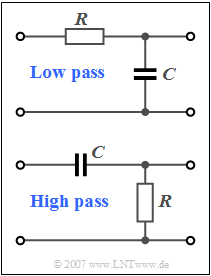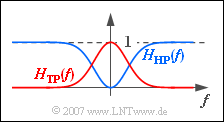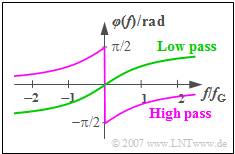Exercise 4.1Z: High-Pass System
The relationships shown on the page Properties of Bandpass Signals apply not only to signals and spectra, but also in the same way to
- the frequency response $H(f)$ and
- the impulse response $h(t)$
of an LTI system. These are also related via the Fourier Transform . More information on this can be found in the book Linear and timeinvariant systems.
The circuit shown in the upper diagram is the simplest realisation of a low-pass filter:
- For very high frequencies, the capacitance $C$ acts as a short circuit, so that high-frequency components are no longer included in the output signal.
- In contrast, low-frequency signal components are only imperceptibly attenuated by the voltage divider.
- With the 3dB–cut-off frequency $f_{\rm G}$ , the following applies to the frequency response:
- $$H_{\rm TP}(f) = \frac{1}{1 + {\rm j} \cdot f / f_{\rm G}} = |H_{\rm TP}(f)|\cdot {\rm e}^{-{\rm j}\hspace{0.05cm}\cdot \hspace{0.05cm} \varphi_{\rm TP}(f)} .$$
In the second part of the equation, the frequency response $H_{\rm TP}(f)$ is split according to magnitude and phase.
The impulse response $h_{\rm TP}(t)$ is obtained by Fourier transformation of $H_{\rm TP}(f)$, where the time constant $\tau = R \cdot C = {1}/({2\pi \cdot f_{\rm G}}) $ is to be set.
For $t < 0$ the impulse response is identically zero, for positive times:
- $$h_{\rm TP}(t) = \frac{1}{\tau} \cdot {\rm e}^{-t / \tau} .$$
The circuit shown below describes a high-pass filter whose frequency response $H_{\rm HP}(f)$ and impulse response $h_{\rm HP}(t)$ are to be determined in this task. Such a high-pass can also be interpreted as a limiting case of a band-pass.
Hints:
- The task belongs to the chapter Differences and Similarities of Low-Pass and Bandpass Signals.
Questions
Solution
- Der Gleichsignalübertragungsfaktor ist $H_{\rm TP}(f = 0) = 1$.
- For the magnitude frequency response holds:
- $$|H_{\rm TP}(f)| = \frac{1}{\sqrt{1 + ( f / f_{\rm G})^2}} .$$
- Thus, the value at $f_{\rm G}$ is equal to $\sqrt{1/2}$. The power transfer function $|H_{\rm TP}(f)|^2$ is therefore only half as large at $f = f_{\rm G}$ as at $f = 0$, which is the reason for the designation „3dB–cut-off frequency” for $f_{\rm G}$ .
- The phase function is generally calculated according to the following equation:
- $$\varphi_{\rm TP}(f) = -\arctan\frac{{\rm Im}\left[H_{\rm TP}(f)\right]}{{\rm Re}\left[H_{\rm TP}(f)\right]} .$$
- With the conjugate-complex expansion one obtains:
- $$H_{\rm TP}(f) = \frac{1}{1 - ( f / f_{\rm G})^2} - \frac{{\rm j} \cdot f / f_{\rm G}}{1 - ( f / f_{\rm G})^2}.$$
- Substituting this result into the above equation gives:
- $$\varphi_{\rm TP}(f) = \arctan\left(f / f_{\rm G}\right) .$$
- The progression is monotonically increasing from $0$ $($at $f = 0)$ via $\pi/2$ $($at $f = f_{\rm G})$ to $\pi$ $($bei $f \rightarrow \infty)$ .
(2) On the page Properties of Bandpass Signalsit was shown that any band-pass signal can be represented as the difference of two low-pass signals.
The same applies to frequency responses:
- $$H_{\rm BP}(f) = H_1(f) - H_2(f).$$
- If we set $H_2(f) = H_{\rm TP}(f)$ and consider $H_1(f) = 1$ as the limiting case of a low-pass function with an infinitely large bandwidth, we get:
- $$H_{\rm HP}(f) = 1 - H_{\rm TP}(f).$$
- As the graph shows, the result is now a high-pass because of $H_1(f) = 1$ . With the given low-pass function $H_{\rm TP}(f)$ one further obtains:
- $$H_{\rm HP}(f) = 1 - \frac{1}{1 + {\rm j} \cdot f / f_{\rm G}} = \frac{{\rm j} \cdot f / f_{\rm G}}{1 + {\rm j} \cdot f / f_{\rm G}} .$$
- For $f = 0$ $H_{\rm HP}(f = 0) \;\underline{= 0}$ is obtained. Note that it is the actual (complex) function $H_{\rm TP}(f)$ and not its magnitude that is to be subtracted. Therefore, the above sketch is to be understood only qualitatively.
One arrives at exactly the same result starting from the concrete circuit on the information page. Corresponding to a frequency-dependent voltage divider with resistors $R$ and $1/(j\omega C)$ applies:
- $$H_{\rm HP}(f) = \frac{R}{R + 1/({\rm j}\cdot \omega \cdot C)} = \frac{{\rm j}\cdot \omega \cdot C \cdot R}{1+{\rm j} \cdot \omega \cdot C \cdot R} = \frac{{\rm j} \cdot f / f_{\rm G}}{1 + {\rm j} \cdot f / f_{\rm G}}.$$
(3) : The correct solutions are 2 and 3:
- The magnitude function of the high-pass is:
- $$|H_{\rm HP}(f)| = \frac{|f / f_{\rm G}|}{\sqrt{1 + ( f / f_{\rm G})^2}} .$$
- At the cut-off frequency $f_{\rm G}$ , the magnitudes of the high-pass and low-pass frequency response are thus equal, namely $0.707$ each.
- On the other hand, the first statement is obviously wrong: According to this, the value $|H_{HP}(f = f_{\rm G})| = 1 – 0.707 \approx 0.293$ should result.
- The frequency response calculated under (2) can also be represented as follows:
- $$H_{\rm HP}(f) = \frac{( f / f_{\rm G})^2 + {\rm j} \cdot f / f_{\rm G}}{{1 + ( f / f_{\rm G})^2}} .$$
- This gives for the phase function:
- $$\varphi_{\rm HP}(f) =-\arctan\frac{f / f_{\rm G}}{( f / f_{\rm G})^2}= -{\rm arcctg} ({f}/{f_{\rm G}}) $$
- $$\Rightarrow \hspace{0.3cm}\varphi_{\rm HP}(f) = {\rm arctan} (\frac{f}{f_{\rm G}}) - \frac{\pi}{2}= \varphi_{\rm TP}(f)- \frac{\pi}{2}.$$
- At positive frequencies, therefore, the same course as with the low-pass system results, except for a shift of $\pi /2$ downwards. Since the phase function is odd, there is an upward shift of $\pi /2$ at negative frequencies.
(4) Proposed solutions 2 and 3 are correct:
- Due to the linearity of the (inverse) Fourier transformation, the following applies to the time course for $t > 0$:
- $$h_{\rm HP}(t) = h_1(t) - h_2(t)= \delta(t) - \frac{1}{\tau}\cdot {\rm e}^{-t / \tau} .$$
- The Dirac function is the inverse Fourier transform of the constant frequency function „1”.
- The second component is identical to the LP impulse response except for the sign.
- The Dirac function causes $h_{\rm HP}(t)$ to be infinitely large at time $t = 0$ .In contrast, the following applies for $t = \tau$:
- $$h_{\rm HP}(t = \tau) = - \frac{1}{\tau}\cdot {\rm e}^{-1} = - {{\rm e}\cdot \tau}^{-1}.$$
- The last statement is therefore also false due to the sign.


